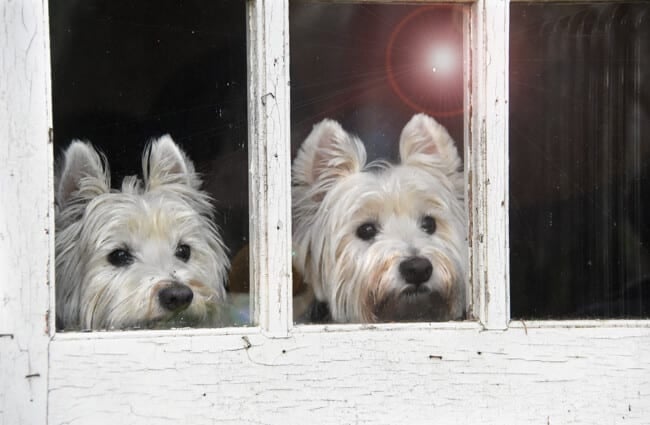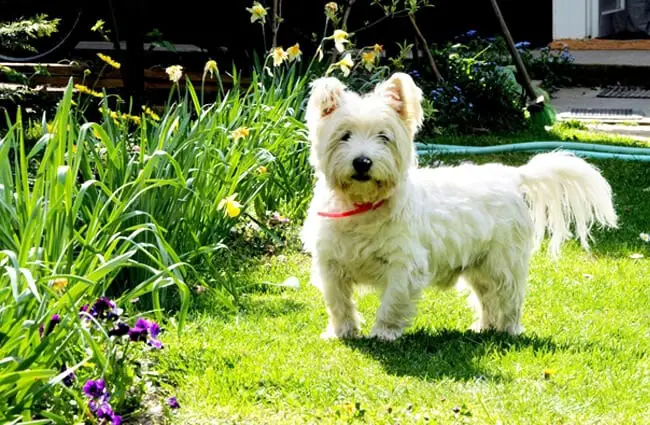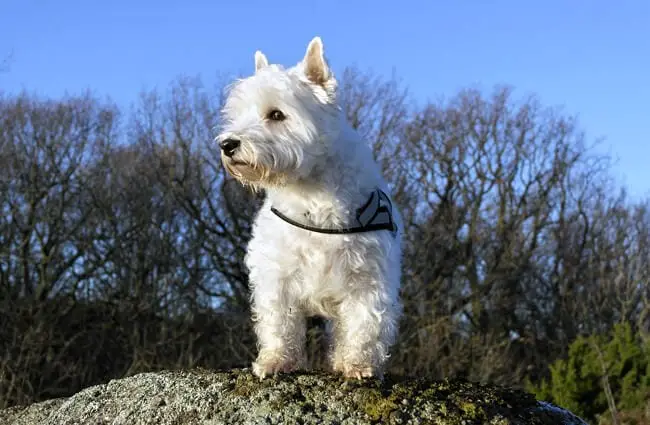The West Highland White Terrier is the quintessential terrier. These dogs are known for their fluffy looking, yet harsh, coats that come in a lovely snowy white.
Although they may look like real life teddy bears, these are still terriers we’re talking about. They’ve got personality and spunk. There won’t be a dull moment with these charmingly clownish dogs. Read more to learn about the West Highland White Terrier.
Description of the West Highland White Terrier
Despite their short stature and friendly faces, the Scotts bred these dogs for hunting. They were meant as ratting terriers in the Scottish Highlands, first bred on the Poltalloch Estate. However, today they are immensely popular pets. They’re even used as the mascots of many popular brands.
While the West Highland White Terriers retain their tenacity, they are calmer than some terriers indoors, and are more gentle in their play. These dogs are some of the most popular terriers in the world.
Life Expectancy and Size
This breed is quite short, but they are sturdy. Westies generally stand 10 to 11 inches tall and weigh 15 to 20 pounds.
They usually live a healthy 13 to 15 years.
Protective Ability
Westies can make relatively effective watchdogs. The traditional terrier spirit is alive and well in this breed. They love to bark and feel that they’re doing an important job for the family. However, these dogs are quite friendly when it comes down to it. They won’t be chasing off intruders, but might lick them to death!
Training
The West Highland White Terrier is a typical terrier and his training follows suit. They’re quick and can bore easily. However, that means Westies are also capable of learning quite a bit. Change up situations and settings often. Avoid too much repetition to keep these dogs entertained.
Training the Westie works best when approached in a very positive manner. They’re not overly sensitive to verbal and physical correction, like some terriers. However, training works best when you stay consistently positive. Westies are well attuned to their people and respond best to reward-based training using treats. If you’re concerned about your dog’s weight, reduce meal size.
Energy Level
Remember that these are terriers. Westies are quite high energy and it will be important to keep your Westie occupied, even if it’s just with play. A little physical activity will go a long way.
However, West Highland White Terriers are calmer and more adaptable than many infamous terriers like the Jack Russel. As long as they receive some sort of daily exercise, they should not get into too much extra trouble.
What Living with a West Highland White Terrier is Like
Westies are funnier than they are crazy. They provide all of the joy and activity of the typical terrier. However, they also tend to be less rowdy indoors and most families can manage them quite well.
Plus, with their expressive eyes and shiny white coats, they’re adorable specimens. Westies do require some coat maintenance, but for many it’s worth their keep.
Care of the West Highland White Terrier
This breed is a good choice for owners that want a hardy small dog that isn’t a lap dog who is extremely fun to live with.
Environmental Needs
The West Highland White Terrier is adaptable beyond anything else. They have full enough coats, but most people trim them so they never become too hot in the summer. These terriers were meant to perform in the harsh Scottish countryside. Today, they can handle just about anything a family throws at them.
Exercise Needs
Although the Westie is an energetic breed, they are not so difficult to keep fit. They do best with a safe, enclosed yard. This breed enjoys running about and playing as opposed to being outside alone.
Your Westie will truly appreciate regular walks, which will ensure that he receives directed activity – and, he’ll get all his excess energy out. Their legs aren’t long, so they may not be able to keep up on runs or bike rides.
Many individuals enjoy doggie sports like obedience or agility. In fact, their work ethic makes them prime candidates. Many win regularly in the show ring.
Shedding and Grooming
This breed requires brushing once or twice a week. Baths once a month should be sufficient to keep the Westie clean. In fact, too many baths can damage the coat.
Periodic clipping is all but required. Most clip once a month, keeping the Westie looking their classic selves. Other traditionalists hand strip, or pull out individual hairs. However, this technique is growing increasingly rare.
Ideal Home Environment
This breed is great for a family that wants a classic terrier. However, Westies also enjoy hanging out with the family and gently playing. An ideal owner isn’t looking for a lap dog, but wants an amusing addition to the family.
They may not be well suited for families with small children, because they do not handle teasing well. Their short legs are quite springy, but still may not be able to keep up with extremely athletic owners.
Health Concerns
Joint pain and heart disease can be a problem as the Westie ages. Working with a reputable breeder and maintaining these dogs’ fitness is the best bet to help them live long, healthy lives.
Behavior Problems
Westies have classic terrier issues. Some may chase, dig, or chew. While early obedience training helps, remember that the best solution is simple. Westies usually calm right down when they have adequate exercise opportunities and they’re allowed to challenge their busy minds with interesting jobs.


























![Red Angus Closeup of a beautiful Red Angus cowPhoto by: U.S. Department of Agriculture [pubic domain]https://creativecommons.org/licenses/by/2.0/](https://animals.net/wp-content/uploads/2020/03/Red-Angus-4-100x75.jpg)

